Brentwood Finally Addressing Poor Pedestrian Connections
A friend sent me a link to this alert issued by the City of Brentwood on December 1, 2010:
Brentwood Pedestrian & Transit Improvement Project
The design phase of the Brentwood Pedestrian & Transit Improvement Project is now underway. The City was awarded $664,000 in federal transportation enhancement funding for the project through a competitive grant program administered by East West Gateway Council of Governments. The City of Brentwood selected two engineering firms, CDG Engineers and Crawford Bunte Brammeier, through a competitive bid process to design two miles of new sidewalks connecting the Brentwood MetroLink station to area shopping centers and employers. The new sidewalk starts in the Brentwood Pointe (Dierbergs) shopping center and will continue south along Hanley Industrial Court, providing safe pedestrian access to the south entrance of the Brentwood Promenade. It then connects with the existing sidewalk on Strassner Drive by Memorial Park. The design phase is scheduled for completion by the end of September, 2011. Construction will start in 2012.
I’m glad I saved a PDF of the alert on the 7th, by the 9th it was gone:
 But onto the actual issue, connecting the Brentwood MetroLink station to adjacent retail.  I’ve experienced all the retail in this area as a motorist but on one day, 6/19/2008, I experienced it as a pedestrian. What a horrible experience it was too. Did I get from the MetroLink platform to Trader Joe’s and back without getting struck & killed? Obviously, but not getting hit by a car is not how you’d describe a good pedestrian environment.
But onto the actual issue, connecting the Brentwood MetroLink station to adjacent retail.  I’ve experienced all the retail in this area as a motorist but on one day, 6/19/2008, I experienced it as a pedestrian. What a horrible experience it was too. Did I get from the MetroLink platform to Trader Joe’s and back without getting struck & killed? Obviously, but not getting hit by a car is not how you’d describe a good pedestrian environment.
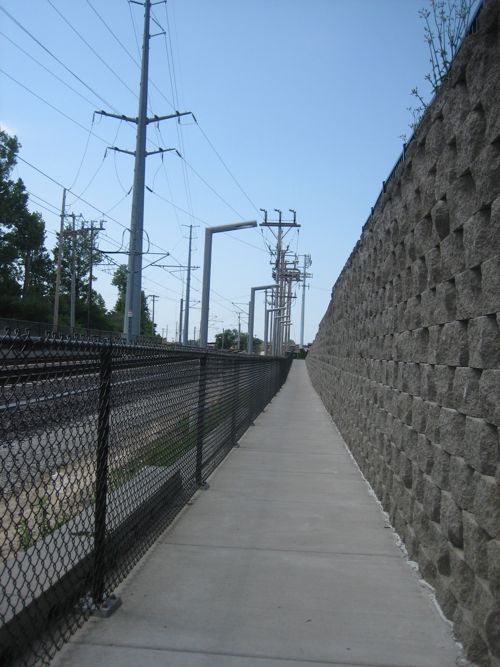
The journey starts with the narrow & long path up to grade from the west MetroLink platform. At the top you see the grim reality of what the pedestrian will find at the top.
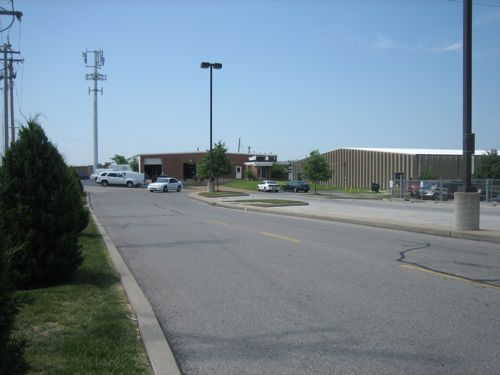
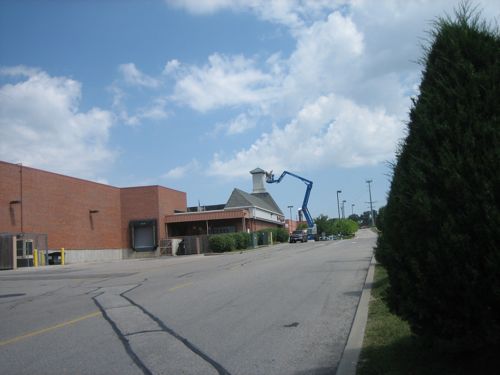
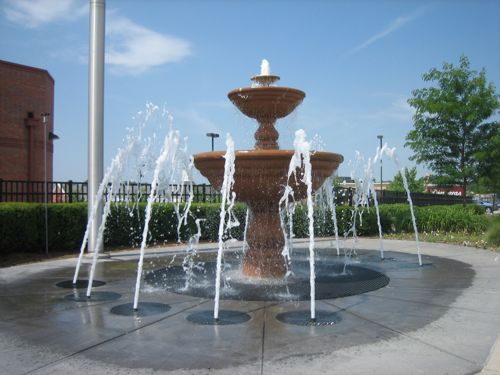
I got to to the Trader Joe’s in the next development but it was not an easy task. Below is an aerial showing the route (blue) from the MetroLink station on the right to Trader Joe’s
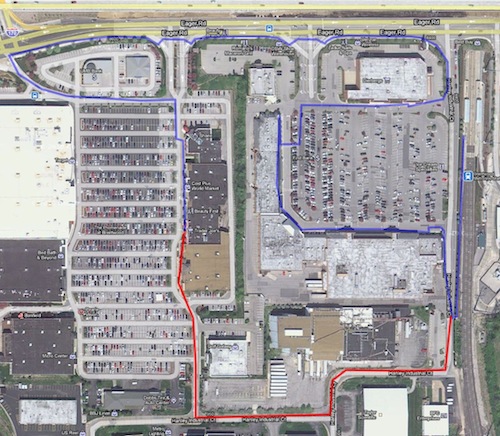
It was kind of a crazy route because I was trying to find a way other than just through a parking lot. You see on the day I made this trip I was still a few weeks away from driving again post-stroke. Transit and my power chair was my only option to reach Trader Joe’s.
I felt unsafe going to/from a store that is very close to expensive transit infrastructure. I talked to a couple of lawyers that take ADA cases. They liked the case but they didn’t have $30,000 to bring a suit. I feel Brentwood was primarily responsible since they acquired the land for the developments. When built next to the rail line they knew future plans called for a station. The fact it wasn’t built to handle pedestrians is shameful.
The fact another $664,000 tax dollars needs to be spent to improve the area is frustrating. Why wasn’t this built better to begin with? Someone at Brentwood was asleep! And this project only gets you to the edge, “providing safe pedestrian access to the south entrance of the Brentwood Promenade.”
Once at the south entrance you still cannot safely visit each merchant. Look for lots of money to be spent in the coming decades retrofitting pedestrian access where it should have been in the first place. I’m not saying this shouldn’t be done now, it just should have been better planned so the best pedestrian route wasn’t the back way through an industrial park.
– Steve Patterson
What makes me scratch my head is why the municipality would be required to intervene and ensure that proper pedestrian pathways are included in each of the projects mentioned above. Surely, the vehicle traffic flow was already incorporated into the design. Clearly, sidewalks between stores did not have to be spelled out. Obviously, doors were installed on the stores to make sure people could walk in and shop.
Maybe there is something I am missing here. I am no professional urban planner or commercial developer. But the fact that another chunk of money is being spent to put in sidewalks seems ludicrous to me.
Were these developers not aware that St. Louis County offers public transit and so would need to include well planned pedestrian access in their designs? Had they no insight into the coming light rail station? Do developers seriously need our elected officials to hold their hands and spell out every detail of common sense in construction and design? Do designers have no understanding of just how much of their projects affect our community and the daily lives of many people?
In the end, if one's project does not include sidewalks for pedestrians approaching the development by public transit, one is either incompetent, embarrassingly lazy or something far worse. I'm not liking any of those options.
I am not a planner either but I work with them on a semi-regular basis. Your question was this:
“Were these developers not aware that St. Louis County offers public transit and so would need to include well planned pedestrian access in their designs?”
This process tends to go something like this:
1) City has an ordinance or demands as a condition of permitting that a developer of a shopping center include sidewalks, bike racks, transit access, ADA access, etc.
2) Developer fights tooth and nail to be excused from said requirements/requests
3) City and Developer come to some compromise over the dispute which generally means the access is incomplete or nearly non-existent.
4) Pedestrians, cyclists, transit users, disabled complain about center's lack of accessibility for their transportation mode.
5) City recognizes the problem and requests Transportation Enhancements or some other federal funds (sometimes they even spend their own money!) to build access for all users.
6) Tax dollars end up covering the cost of something the developer should have been required to do in the first place
So, it's less of an issue of the developer failing to recognize the needs of bikes/peds/transit users but rather an outright refusal to cooperate with the city. If the city has makes no demands or has lax development standards then there is about a 100% chance you'll get a cement box surrounded by unwalkable parking lots.
My guess is that Brentwood dropped the ball when this center was created especially with a facility so terribly designed.
Granted there are developers who are better than others in this regard and will choose to build access for all users without being told. Sadly most developers need their hands to be held.
What drives me batty is that those developers who need the government to spell out Urban Planning 101 are generally the same crowd who support “less gov't” political camps. This group of blind developers want more freedom from gov't, but make decisions which guarantee more gov't involvment in their dealings.
I too want less gov't. My opinion is that the private sector is what makes our economy go and needs less gov't standing in its way, not more. But if some members of the private sector do not maintain the best interests of teh community in their decisions and actions, gov't is left with no alternative but to step in.
It's a personal crusade, lol, but I would love less gov't and more responsible behavior from private enterprises. Prudent, wise decisions reflecting a proper understanding of the important role they play in our community would give commercial developers the freedom they want.
That's it! lol I'm gonna beef up the ethics depts at our area business schools and put some common sense into these folks. You can make money and make a better community at the same time. The two are not mutually exclusive.
And I'm not denying Brentwood dropped the ball.
But what a shame there was a ball to drop. This should have been handled by the likely brilliant and well-educated design team or demanded by a wise investors.
I guess sometimes common sense is too much even for people like that. blah.
There are many to blame here. The fact is many acres were cleared and rebuilt after it was know a light rail station may get built makes the current situation that much worse. They could have done a much better job, but chose not to.
The city of Brentwood agreed to these poor pedestrian designs and stood idle when the management of the Dierberg's plaza prevented a ramp or staircase near the Metrolink Platform. Dierberg's was terribly afraid of people parking there for MetroLink. Instead, the long retaining wall and sidewalk to the back of the property were built as a work around on Metro's dime.
Now Brentwood will receive federal money to remediate the problem. Sure seems like an irresponsible use of federal funds that could have been prevented with a little foresight, planning, and compromise. Despite that, I'm glad the design is being addressed.
It is another example of the garbage planning so typical of this region. That Brentwood metro stop is a joke on the public and improvements will only be marginally helpful.
When these stations are planned originally they should get the full commitment from the muni and private landowners to revamp the surrounding urban design to serve transit users. Absent that commitment, the transit authority should find another location for the station, even to the extent of rerouting the whole transit line if necessary.
The way it stands this stop is almost useless, improvements may help, but it was a poor choice from the outset.
This stop is a poster child for why transit is often not successful. It simply is not a desirable stop due to the configuration of walkways and surrounding buildings. I seriously doubt many people take transit to go shopping in this area, why bother? The only people this stop serves is people without access to automobiles desperate to shop at one of the stores.
For transit to be successful it must be convenient and appeal to everyone, not just the narrow segment of the population who can't afford a car. The overall plan discourages walking to nearby destinations. And if you are in a wheelchair, forget it. Then everyone wrings their hands when transit ridership is weak and wonders why.
You have to ask if all these government officials are that stupid or they don't care? Which is it? This is Urban Planning 101 we are talking about here. Ultimately it is the fault of MetroLink for putting a stop at this location. The bottom line is that it is ill conceived and poorly done. It's going to take a lot more the $664,000 to fix it.
And then they hire engineers. Engineers know very little about the use of urban space and design, but hey, at least the sidewalks will drain rain water pretty well. The fiasco continues.
How about the wheelchair ramps at some of the new metrolink stations (Big Bend is a good example) that make you have to walk the length of the ramp (several hundred feet more) once you get to the entrance of the station? This setup effectively removes even the buildings next door from the “walkable” range. Besides the measurable time and effort required, the frustration of having to walk back and for absolutely no reason is a great deterrent to use of the stops. I'm not saying not to have wheelchair ramps, but when they're building ramps, why can't they also build a simple staircase at the same time?
Steve, I hope you stay on top of this and let us know if there are any opportunities for the public to have some input.
I just get mad whenever I think about this stop and mostly don't use it. You have to wonder who is getting off at this stop, other than the people using the parking garage. The only destination convenient to the stop is Mai Lee Restaurant – and I love that place.
At the end of the day, for the most part no one dropped the ball nor anyone did the lack ability to comprehend urbanism and various planning options. It is the harsh reality of a city finding a way to optimize revenue in the short term. For Missouri cities it means running with what will generate tax revenue outside of property tax and that is sales tax
Where Brentwood is missing the point with this grant is that Dierbergs has significant competition and I would be surprised if their sales year after year haven't been falling with Target and Walmart trying to lure shoppers with groceries, think Target expansion next door and the rebuilt Hanley Walmart into a superwalmart. Instead of improving access around their store, Brentwood should be actively talking Dierbergs on how to redevelop the site and how a street grid can be improved. Better yet, TDD's are ahead on making schedule payments. They can roll these funds into new initiatives without an impact to their city revenues.
In other words, yes it is a cluster and you spend time complaining about what has been done. Instead, Brentwood is finally realizing what is going on (that people actually use transit and offers opportunities) and what are the solutions and how should these funds spent to maximize or make the most impact?
I've said it before and I'll say it again, developers are in business to make money, period. They're not out to make friends or to improve the environment. They're not out to make great architectural statements nor are they very interested in helping any groups on the fringes of the demographic they're trying to attract – too much effort for not much return on investment. They may not like playing by any rules, but they will if everyone plays by the same ones and money can still be made.
The big issues here are that neither the developers nor the city recognize pedestrians and transit users as either a large part of their customer base and/or customers who spend large amounts in their stores. Yes, one way to get better pedestrian connections is to demand them, because they're the “right” thing to do. The other way is to generate hard numbers to make a valid economic argument – increasing sales by 3% is significant; increasing them by 0.3% is not.
The only two ways real change will happen is when there is a champion in city government pushing the issue and/or someone gets hauled into court and being hit with a large judgement for ignoring the ADA. Until that happens, the status quo sees no reason to change, and no, whining about it on a blog carries little real weight.
JZ, I really thought my post would have a lasting impact on the future development of St. Louis. Thanks for setting me straight.
Yes, developers are in business to make money. These firms are not charities. But if money's all these folks want, they'd learn to game blackjack tables or manage a hedgefund. These folks are also in business to create. Hopefully to create successful retail/commercial spaces.
I hesitate to lump any group all together. There are worse and worst developers. LOL Clearly, the design/development team of the new Busch Stadium had architectural significance in mind when thinking up the stadium. Great care was also put into how the patron experience would feel.
I'm quite certain that all developers don't sit in harsh, demeaning places and scheme the next way to make life more disjointed and miserable for the rest of us. Some do, maybe. But others sit in church pews, attend little league games and walk their dog with the community. These people should be smart enough to design and develop spaces that make money and improve a neighborhood. Is it up to them alone without input from municipal gov't, bankers, retailers? No, of course not. But if we wait for every good idea to be legislated, mandated or driven by even more profit, we'll be old and toothless. Community works because individuals choose to follow the law and common sense and make good choices. I'm suggesting that developers be encouraged to do the same.
Define “create successful retail/commercial spaces.” To me and many other urbanly-conscious people, it's one answer. To most shopping center developers, it's fully-leased space. They do whatever is necessary to generate positive cash flow, and what's needed and expected in Palm Beach or along Rodeo Drive is quite a bit different than what's needed or expected in Arnold or along Eager Road. Yes, many of them are capable of grasping many urban design nuances, but they are driven by the numbers, the bottom line. Could they put in better landscaping, higher-quality materials and valet parking? Of course, but why would they? People are coming in droves (relatively speaking), without any of those amenities, their competitors aren't doing it and the city has few, if any, requirements!
These people ARE “smart enough to design and develop spaces that make money and improve a neighborhood.” And you're right, the government shouldn't have to hold their hand every step of the way. The real “problem” is us, midwestern consumers. We shop where we shop and we don't demand any better as customers. Our money talks, retailers listen. We get snow shovels in November and sun screen in May. Golden Corral and Hometown Buffet are doing great. Businesses only close or move when they're not profitable. Our dollars are votes and we're, by and large, voting for crap!
One small, local example of retail and development being not far removed from the blackjack table or the stock market – last summer, the local franchiser of Rally's Hamburgers shut down several existing locations (Chippewa & River Des Peres and Manchester west of Hanley, to name two) while keeping four locations open (http://rallyshamburgers.com/lo…). Physically, the locations are virtually identical, a prefab box in a parking lot, yet some were not successful, while several apparently continue to be.
They didn't shut the locations down out of boredom, they shut them down because they weren't profitable, period. Local consumers chose to spend their money elsewhere. They might not have liked the food, the service, the prices, the fact that there was no dining room, that they weren't pedestrian friendly and/or they didn't fit the existing urban fabric. It doesn't matter, people spent their money somewhere else, and their votes counted! Bigger picture, we may question why they seem to be more successful in lower-income neighborhoods (less competition? different expectations? better value?), but it's still secondary.
We get the businesses we support and we lose the ones we don't. Northwest Plaza and Crestwood Court are essentially dead because nearly all of their tenants have moved out/closed, yet their locations at West County and South County are still open. The big box retailers here are no different – they'll stay open as long as customers continue to show up, in spite of horrendous pedestrian access and pretty crappy vehicular access. Until we, as a society, do a better job of rewarding the urban design we want and penalizing the urban design we despise, we're going to get more of what's been proven to be financially successful – see Shrewsbury's current efforts to replace Kenrick Plaza with a Super Walmart . . .
The entire Shrewsbury Metrolink line is a disgrace. The Skinker Station is the exception that proves the rule in terms of pedestrian access and a coherent relationship to the surrounding neighborhood.The Sunnen Station is cut off from humanity and doesn't even have a shelter at which to wait for the bus. The Galleria/St. Louis Boulevard station is hidden from the vast retail centers as if it were an embarrassment. The Forest Park Station is separated from the city's “crown jewel” by a busy four lane parkway with a dangerous, awkward, ugly crosswalk and then a long unshaded, unprotected walk along nowhere land.
I agree that Brentwood Station is the worst of the lot, but I've never understood why the various design failures of that line haven't been a scandal all along.
What scandal? nor do I think its a disgrace. A lot decisions come down to economic realities. Simply put, Forest Parkway alignment, mostly undergroud, that gave the cherished Skinker station was a huge cost. The trade off was using an existing railway right of way to get from Clayton to Shrewsbury. Even then, Metro almost went bankrupt. The result, until prop A was passed, was to hollow out bus service and reduce metrolink frequency. Second, box stores and parking lots can be re-used or re-developed just as any other property.
I'm with JZ, you have to make an economic argument at end of the day. One argument you might make for Dierbergs is that they don't have competitive advantage in Brentwood anymore. However, they would literally have great access to a wider demographics if they embrace Metrolink. Give time, provide an argument and you might be surprised.
Tomorrow, Tue, 11th Jan, Metro is hosting a presentation by the Mid West High Speed Rail Association. The topic is the 2 hr high speed bullet train from St. Louis to Chicago.
Since it is at Metro, and there will be many folks there from Metro, perhaps this a good venue to address either this specific question (or in general) with someone who was part of the design group, and folks who care about pedestrian and mass transit access to things.
Hope to see you tomorrow.
Just to keep it real. Brentwood does not “REALLY” want people walking around. I frequent there all the time in my car and just wonder who would actually try to take Metrolink there.